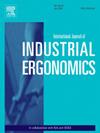Impact of altitude on worker health and project efficiency in tunnel construction
IF 2.5
2区 工程技术
Q2 ENGINEERING, INDUSTRIAL
International Journal of Industrial Ergonomics
Pub Date : 2025-01-01
DOI:10.1016/j.ergon.2024.103694
引用次数: 0
Abstract
The number of high-altitude tunnel construction projects in China is increasing, but the low-pressure and low-oxygen conditions in these areas pose significant safety risks to workers. The specific effects of such environments on construction workers are not fully understood, making it essential to compare the physiological indicators and labor intensity of workers in plain and high-altitude regions. This study used field tests, two-way ANOVA, and theoretical analysis to assess workers in typical plain and high-altitude tunnel construction. The findings reveal significant differences in physiological indicators, with high-altitude workers showing elevated heart rate, increased respiratory rate, greater cardiovascular strain, and reduced blood oxygen saturation. Altitude is identified as the most critical factor affecting these indicators, followed by the construction process. Interaction effects are particularly evident in respiratory rate and respiratory exchange rate. From an ergonomic perspective, labor intensity increases significantly in high-altitude construction, typically rising by 1–2 levels at 4700 m. Labor efficiency in high-altitude conditions is reduced to 80.28%–89.67% of that in plain areas, necessitating an increase in labor time by approximately 11.61%–24.56%. These findings highlight the need for improved safety management in high-altitude tunnel construction and provide valuable insights for similar projects.
海拔对隧道施工工人健康和工程效率的影响
中国的高海拔隧道建设项目越来越多,但这些地区的低压、低氧条件给工人带来了重大的安全风险。这种环境对建筑工人的具体影响尚不完全清楚,因此有必要比较平原和高海拔地区工人的生理指标和劳动强度。本研究采用现场测试、双向方差分析和理论分析对典型平原和高原隧道施工工人进行评估。研究结果揭示了生理指标的显著差异,高海拔工人表现出心率升高,呼吸频率增加,心血管压力更大,血氧饱和度降低。海拔高度被认为是影响这些指标的最关键因素,其次是施工过程。交互作用在呼吸速率和呼吸交换速率方面尤为明显。从人体工程学的角度来看,高海拔施工的劳动强度会显著增加,在海拔4700米的地方通常会增加1-2级。高海拔地区的劳动效率下降到平原地区的80.28% ~ 89.67%,需要增加的劳动时间约为11.61% ~ 24.56%。这些发现突出了提高高海拔隧道施工安全管理的必要性,并为类似项目提供了有价值的见解。
本文章由计算机程序翻译,如有差异,请以英文原文为准。
求助全文
约1分钟内获得全文
求助全文
来源期刊
CiteScore
6.40
自引率
12.90%
发文量
110
审稿时长
56 days
期刊介绍:
The journal publishes original contributions that add to our understanding of the role of humans in today systems and the interactions thereof with various system components. The journal typically covers the following areas: industrial and occupational ergonomics, design of systems, tools and equipment, human performance measurement and modeling, human productivity, humans in technologically complex systems, and safety. The focus of the articles includes basic theoretical advances, applications, case studies, new methodologies and procedures; and empirical studies.

 求助内容:
求助内容: 应助结果提醒方式:
应助结果提醒方式:


